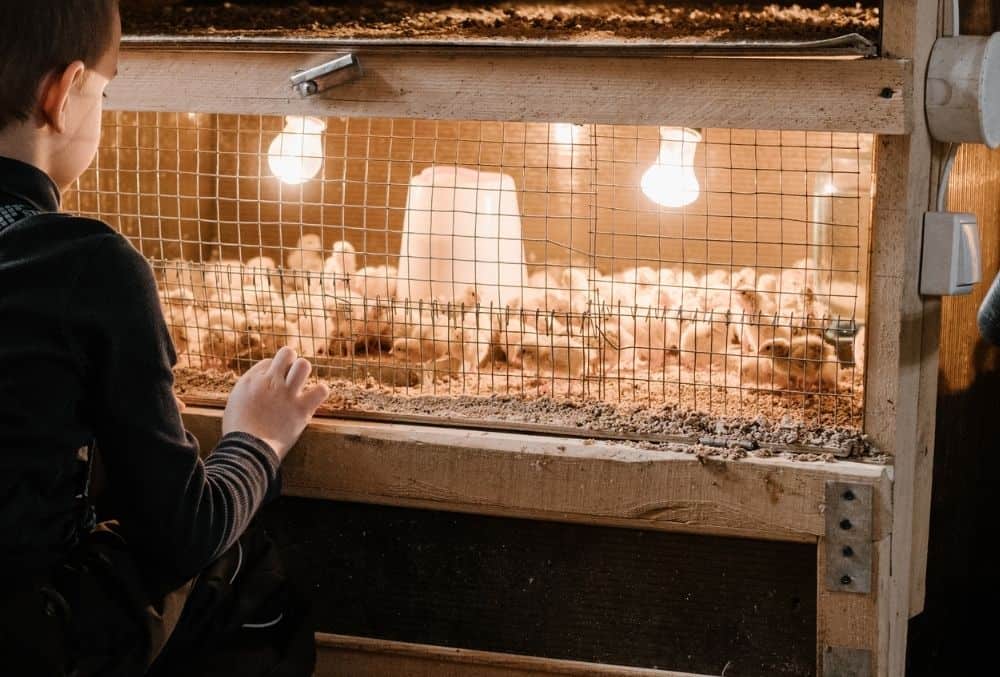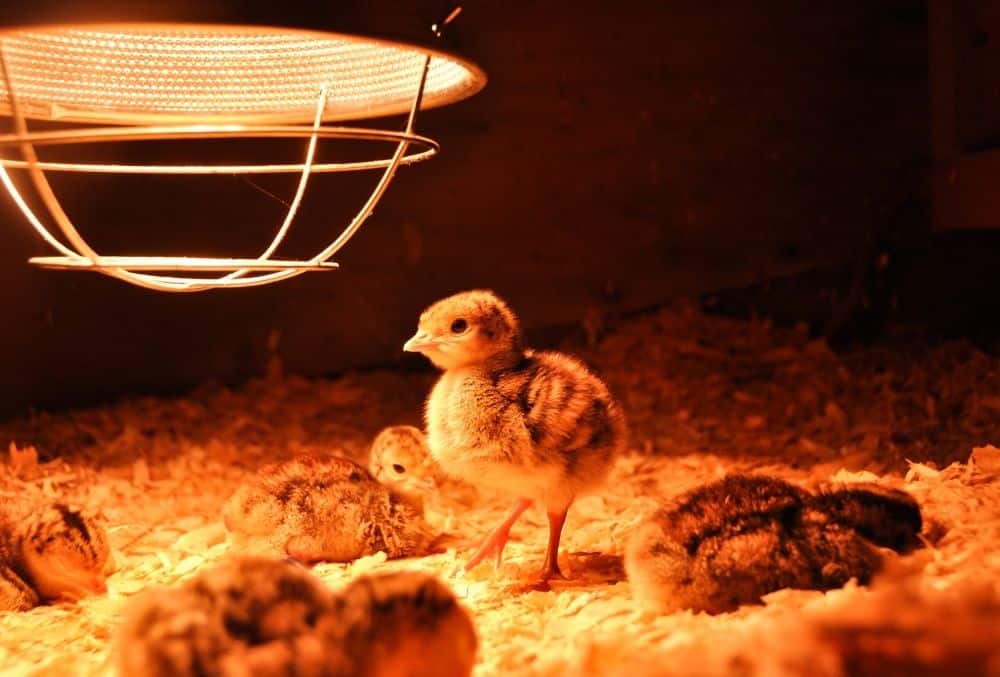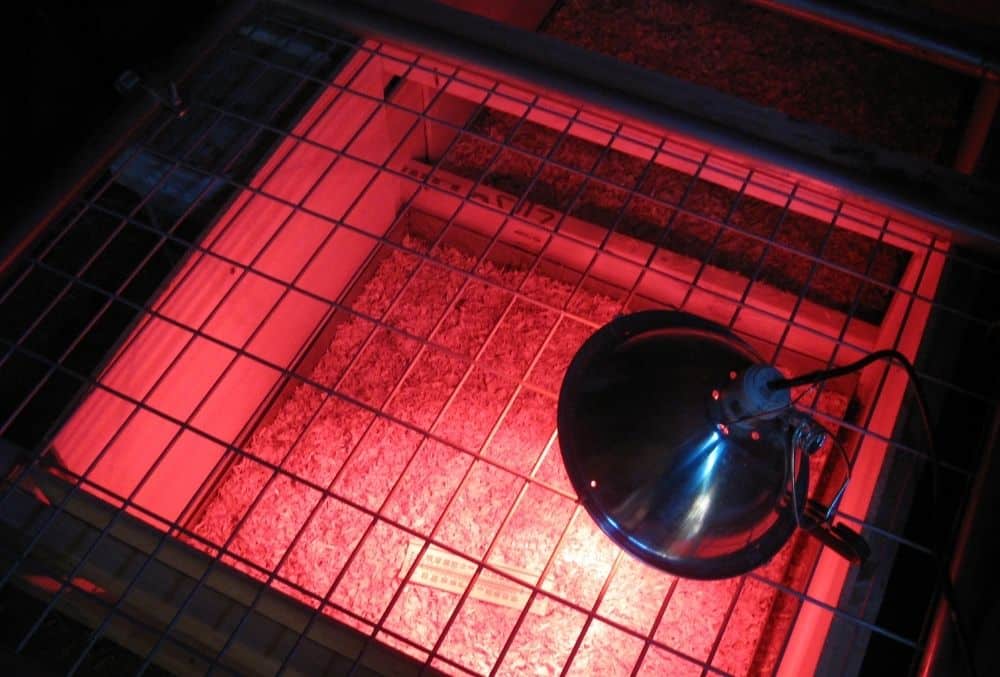When chicks are first born, they don’t have feathers and therefore aren’t able to regulate their own body temperature, meaning they require a heat lamp to keep them warm.
If you’re wondering how long chicks need a heat lamp, you’ve come to the right place.

In this article, I will explore some key information about how to care for chicks on your homestead, including how long they need a heat lamp.
Keep reading to find out more.
Raising chicks to chickens on your homestead is a great way to enjoy a variety of benefits that will make you more self-sufficient in the long run.
However, if you don’t have a mother hen to raise your chicks, there are a variety of considerations you will need to bear in mind before your chicks hatch.
For the most part, this comes down to building a brooder, preparing it properly with a heat source, and monitoring their temperature daily to ensure that they are as healthy as possible.
What Is A Brooder?
In short, a brooder is a warm environment that is designed to mimic a mother hen’s body heat. This is where your chicks will live for several weeks on your homestead when they are first born.
Whether you opt to buy a commercial brooder or decide to make your own brooder for your chicks, they are a fundamental part of raising chicks without a mother hen.
Brooder chicks require heat lamps and must be closely monitored with thermometers to ensure that they are able to survive.

Generally speaking, any lamp with 100 to 250-watt bulbs will provide a sufficient amount of heat for approximately a dozen chicks, so you will need to adjust accordingly to the amount of chicks you have.
Typically, the recommendation for a brooder temperature is 95 degrees Fahrenheit for the first week after the chicks have hatched. Following this, the temperature can decrease with each week that passes in five degree intervals, although this can vary.
Bearing this in mind, you will need to make sure that you closely monitor the behavior of your chicks when they are in the brooder.
For instance, if they’re all huddled together under the heat lamp, it’s a clear indication that they are too cold and that you need to increase the temperature of the heat lamp.
In addition to this, if they are around the sides of the brooder or are away from the heat lamp, then it could be that they are too hot and you need to decrease the temperature.
As a result, it’s important that you find the perfect temperature to ensure your chicks are comfortable. In order to control and change the temperature within the brooder, you can either raise or lower the heat lamp.
However, it is your responsibility to ensure that the heat lamp is far enough away or isn’t close to any combustible surface. Heat lamps should generally be kept at least two feet from combustible materials at all times to ensure the safety of your chicks.
What Can You Use To Build A Homemade Brooder?
To keep in line with your homestead life, you can make a homemade brooder out of a variety of different items provided that your brooder has:
- A heat source
- Warm bedding
- Water
- Feed
A few materials you can build a brooder out of on your homestead are:
Stock Tanks
Whether you have an old stock tank lying around that you can repurpose, or decide to buy a new one, this is a great option for a homemade brooder.

Plastic Tubs Or Rubbermaid Tubs
If you’ve got a rubbermaid tub lying around your homestead for feeding other livestock, it can also be repurposed as a brooder for your chicks!
Dog Kennels
Every homestead should have a trusty dog kennel, and whether your dog has outgrown it or it’s simply old, a kennel makes an excellent brooder for newborn chicks. That being said, a dog kennel can be tricky to set up a heat lamp inside, so you will need to find an alternative heat source for your brooder.
How Long Do Chicks Need A Heat Lamp?
As chicks are born without feathers and cannot regulate their own body temperature, they require help from a heat source until they are fully-feathered.
When brooder chicks are first born, they solely rely on the warmth from a heat lamp or other heat source to regulate their temperature. The ideal temperature for chicks that are being kept in a brooder and that are seven days old or younger is 95 degrees Fahrenheit.
Typically speaking, the temperature can be decreased to 90 degrees Fahrenheit during week two, and to 85 degrees Fahrenheit during week 3. Typically speaking, each week declines by five degrees until your chicks are ready to live outside in the chicken coop.
However, as I mentioned above, you will need to make sure that you are closely monitoring them and adjusting the temperature in accordance with their behavior to ensure that they’re safe.
Once your chick grows more and more feathers, they will start to rely on the heat lamp less and you will be able to take them outside for short bursts of exercise and play time.
That being said, this doesn’t mean that they are ready to be kept outside full time yet. You will need to make sure that you keep them inside until the temperature outside is the same as the temperature of their brooder inside.
You will also need to make sure that you don’t place them outside if the temperature at night is going to drop below the brooder temperature, as your chicks will not be able to withstand this whilst they are still young.
In Summary
In short, chicks need a heat lamp to keep warm until they are fully feathered and are able to join the rest of your chickens on your homestead.
Always make sure that you are monitoring their temperature and behavior to ensure that they’re warm enough.
